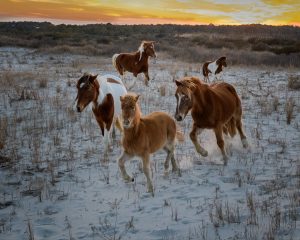
ASSATEAGUE — The March survey of the wild horse population on the Maryland side of Assateague Island revealed the size of the herd stands at a healthy 82 despite six dying this year.
The National Park Service has completed its March 2018 population census of the wild horses on Assateague Island, revealing the total population of the Maryland herd now stands at 82. The target range for the wild horse population on Assateague is 80-100, so with a baby boom of sorts on the island in recent years, offset by the loss of several older horses, most to old age and natural causes, the 82 determined during the March census is right in the ideal range.
The herd currently includes 21 stallions and 61 mares and at least one mare is known to be pregnant at this time. Surprisingly, the census revealed the herd of wild horses on the Maryland side of Assateague Island lost six already in the first three months of 2018 including five mares and one stallion. All the horses determined to be lost were mature, older horses who had lived out their full lives within the national seashore.
The National Park Service completes a full census of the horse population on the Maryland side of the barrier island six times per year in February, March, May, July, September and November. Managed as a wildlife population, the Assateague horses are free to roam over the roughly 27 miles of the barrier island and are difficult to find at times.
During each census, the horses are identified by their distinguishing characteristics, mapped and counted. Individual horses that are not observed over multiple census periods are presumed dead. The purpose of the census is to monitor the population dynamics of the horse herd in support of the long-term fertility control program that was initiated in 1994.
The popular horses on Assateague are wild animals and generally left to the whims of nature. However, in the interest of maintaining a healthy population size, the National Park Service several years ago began a contraceptive program for the mares. In almost each year since, selected mares have been injected, or darted more appropriately, with a non-invasive contraceptive called PZP in an effort to maintain the size of the herd on the Maryland side in its manageable threshold.
At one point, the size of the wild horse population on Assateague had swelled to 140, or well north of the target range of 80 to 100. However, with losses due to old age, illness or other man-made and natural causes, the number of horses in the herd now stands at 82, or just inside the target range.
Each November, annual pregnancy tests are conducted on the mares in the Maryland herd on Assateague through samples taken from defecation. While certainly isn’t infallible, the tests generally serve as good predictors of which mares are expected to birth foals in the coming year. While it certainly isn’t the most glamorous aspect of managing the famed wild horses on Assateague, a biological technician spends much of November conducting pregnancy tests on the many mares on the barrier island in an attempt to determine how many new foals might join the herd next year.
The biological technician follows the mares in the herd essentially waiting for them to defecate. The samples are collected, frozen and sent to a lab to be analyzed to determine if any of the mares will be expecting next spring and summer. The fecal samples are bagged and tagged with the mares’ alpha-numeric name and sent to a lab in Montana for analysis. Just like a human pregnancy test, the lab technicians look for elevated levels of hormones, which would indicate if a mare is likely pregnant or not.
It’s important to note the National Park Service census applies to only to the wild horses on the Maryland side of Assateague Island. The horses on the Virginia side, while believed to be from the same historic stock, are owned by the Chincoteague Volunteer Company and some are auctioned off each summer after swimming across the channel to the mainland as a means to manage that portion of the wild herd.
The release of the census figures provides a good opportunity to remind visitors to enjoy the wild horses from afar and keep a safe distance from the attractive animals, particularly in the developed areas around roads and campgrounds. Last year, at least two of the Maryland horses perished because of man-made interaction, one of which was struck by a vehicle and the other which got into a campsite and ate a large amount of processed dog food.
The Assateague Island Alliance (AIA), or the friends group of the Assateague Island National Seashore, advocates on behalf of the island’s most famed residents. Last year, the AIA started a “Fed Horse is a Dead Horse” initiative in an effort to educate visitors about the importance of keeping a safe distance from the horses and keeping food is securely locked containers, especially in the developed areas of the parks where the horses have grown accustomed to their human visitors.

